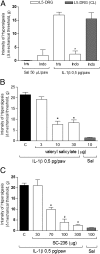Peripheral inflammatory hyperalgesia depends on the COX increase in the dorsal root ganglion
- PMID: 23401543
- PMCID: PMC3587281
- DOI: 10.1073/pnas.1220668110
Peripheral inflammatory hyperalgesia depends on the COX increase in the dorsal root ganglion
Abstract
It is well established that dorsal root ganglion (DRG) cells synthesize prostaglandin. However, the role that prostaglandin plays in the inflammatory hyperalgesia of peripheral tissue has not been established. Recently, we have successfully established a technique to inject drugs (3 μL) directly into the L5-DRG of rats, allowing in vivo identification of the role that DRG cell-derived COX-1 and COX-2 play in the development of inflammatory hyperalgesia of peripheral tissue. IL-1β (0.5 pg) or carrageenan (100 ng) was administered in the L5-peripheral field of rat hindpaw and mechanical hyperalgesia was evaluated after 3 h. Administration of a nonselective COX inhibitor (indomethacin), selective COX-1 (valeryl salicylate), or selective COX-2 (SC-236) inhibitors into the L5-DRG prevented the hyperalgesia induced by IL-1β. Similarly, oligodeoxynucleotide-antisense against COX-1 or COX-2, but not oligodeoxynucleotide-mismatch, decreased their respective expressions in the L5-DRG and prevented the hyperalgesia induced by IL-1β in the hindpaw. Immunofluorescence analysis demonstrated that the amount of COX-1 and COX-2, constitutively expressed in TRPV-1(+) cells of the DRG, significantly increased after carrageenan or IL-1β administration. In addition, indomethacin administered into the L5-DRG prevented the increase of PKCε expression in DRG membrane cells induced by carrageenan. Finally, the administration of EP1/EP2 (7.5 ng) or EP4 (10 µg) receptor antagonists into L5-DRG prevented the hyperalgesia induced by IL-1β in the hindpaw. In conclusion, the results of this study suggest that the inflammatory hyperalgesia in peripheral tissue depends on activation of COX-1 and COX-2 in C-fibers, which contribute to the induction and maintenance of sensitization of primary sensory neurons.
Conflict of interest statement
The authors declare no conflict of interest.
Figures






References
-
- Omote K, et al. Effects of a novel selective agonist for prostaglandin receptor subtype EP4 on hyperalgesia and inflammation in monoarthritic model. Anesthesiology. 2002;97(1):170–176. - PubMed
-
- Smith JB, Willis AL. Aspirin selectively inhibits prostaglandin production in human platelets. Nat New Biol. 1971;231(25):235–237. - PubMed
-
- Vane JR. Inhibition of prostaglandin synthesis as a mechanism of action for aspirin-like drugs. Nat New Biol. 1971;231(25):232–235. - PubMed
-
- Yaksh TL, Dirig DM, Malmberg AB. Mechanism of action of nonsteroidal anti-inflammatory drugs. Cancer Invest. 1998;16(7):509–527. - PubMed
-
- Dirig DM, Isakson PC, Yaksh TL. Effect of COX-1 and COX-2 inhibition on induction and maintenance of carrageenan-evoked thermal hyperalgesia in rats. J Pharmacol Exp Ther. 1998;285(3):1031–1038. - PubMed
Publication types
MeSH terms
Substances
LinkOut - more resources
Full Text Sources
Other Literature Sources
Research Materials

